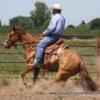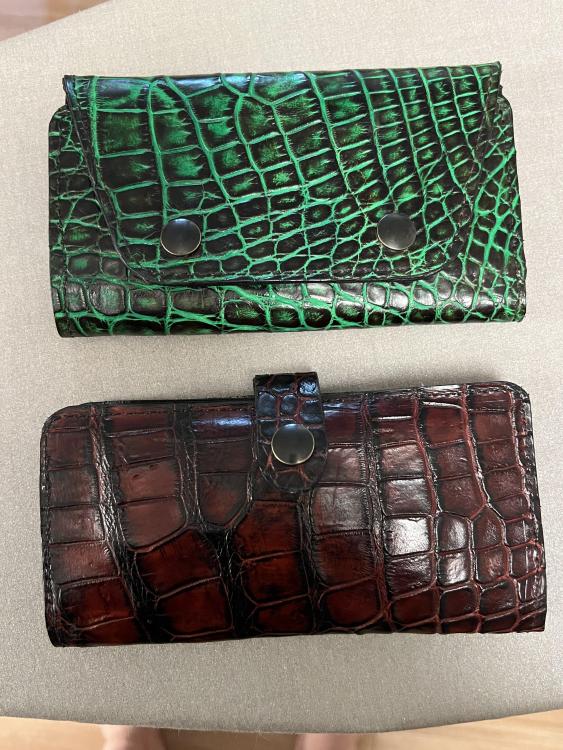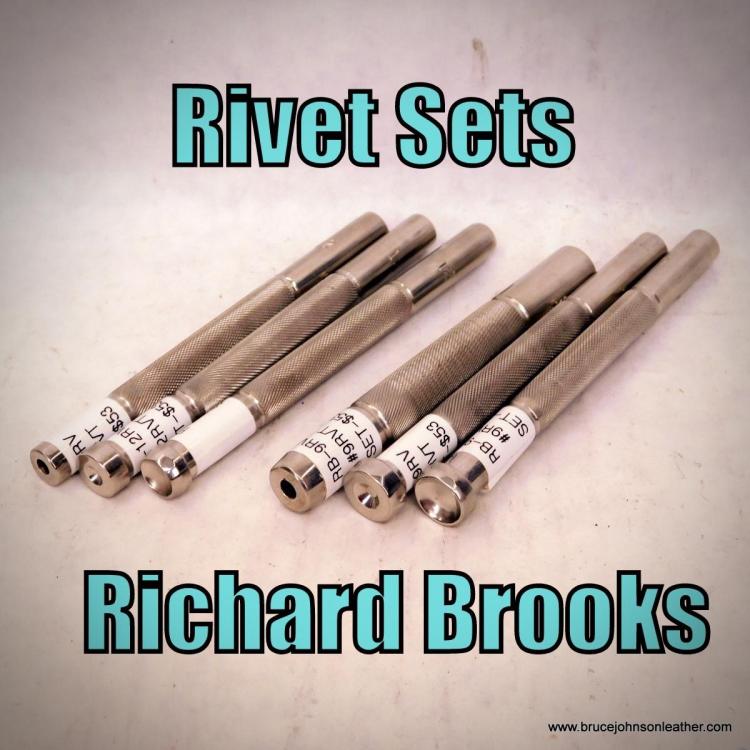-
Posts
4,372 -
Joined
-
Last visited
Content Type
Profiles
Forums
Events
Blogs
Gallery
Everything posted by bruce johnson
-
We are in Sheridan WY for the Rocky Mountain Leather Show this week. My wife Rundi Johnson took a 2 day alligator wallet making class from Broderick Vaughan. They were supposed to make one and ended up with enough spare time to make a second wallet today. They started with alligator crust (undyed). They dyed the gator, made the interiors and assembled them. I think she did a great job and she had fun learning new techniques! Tomorrow we set up the vendor booth for the trade show Friday through Sunday. If you get the chance to take this class she recommends it highly. If you are at the show please stop by our booth!
-
Those really look good Bruce! (coming from a guy who has seen a few....)
- 29 replies
-

Head Gear for a Show Jumper
bruce johnson replied to TomE's topic in Saddle and Tack Accessory Items
Fine looking work! -

High school bull riding safety vest
bruce johnson replied to DonInReno's topic in Leather Sewing Machines
Don, yes I think a heavier thread would be better than the #138. I’m glad you used the term “well meaning”. Realistically, is a bull riding vest the place to cut costs?? They might be saving $100-200 for the kid but if there is a failure vs tested and proven designs made with materials and experience that’s hard to justify. -

Stitch Length Settings on Cobra Class 26
bruce johnson replied to PlanoMike's topic in Leather Sewing Machines
If you are going to any leather shows Chris Andre has a class on tips and tricks for the 26. Good class from people I’ve talked with -
I use the single edge razor blades. They fit my wooden strap cutters and I break off the excess length with pliers.
-

Need Info on American Leather Cutter/Skriver
bruce johnson replied to jkordzi's topic in Leather Machinery
The cutter is pretty self explanatory. Biggest thing is figuring out how to remove or tighten the blades on the shaft. Some have holes and an adjustable spanner wrench will work. If not, the old guy who taught me used a pine board wedged into the two wheels and cranked the handle backwards to bind and lock the blades and unthread them from the shafts. If that doesn't work then a vise grip will but be careful of the blade edge. To reinstall - spin on the inside wheel, then the outside. The board trick nearly always works for tightening them once they are threaded snug. Skiver - slide the blade in to the stop. partially tighten the two hold down bolts. put the "back-up bolt in the blade rest and tighten to the back edge of the blade, then back off about 1/4 turn to allow the blade to sit just behind the stop and tighten the hold downs. That slight allowance keep the blade just a hair back of the stop and prevents chipping that blade corner. The angle of the blade is adjusted at each end. On the side away from the crank, that small knurled eccentic the bolt goes through is rotated and that makes the blade go up and down on that side. Set it and tighten the hexbolt. On the side of the blade nearest the crank, the eccentric has a little "handle" and the bolt on that side has two ears to act like a thumbscrew. Turn the handle to whatever angle you like and tighten the thumbscrew. The gap between the top and bottom roller is what makes the tension to feed the leather through. Narrower gap for mostly thin leather, wider gap for heavier leather. It adjusts by the vertical hex head bolt. The spring helps with tension too and flexes to allow thicker leather through. If the leather feeds but then spins out, narrow up the gap by loosening the hex head bolt. This lets the bottom feed wheel get more of a bite. If it wont feed at all the gap may be too narrow and tighten the bolt. This opens up the gap so the wheels can grab the leather. Play with spring tension as needed. Realistically, once you get this all set you rarely need to change anything on the fly. The guide on the front slides back and forth - feather edge over to the right to a slight skive with a mostly full edge as you adjust it left. Oil the ports every so often, grease gears as needed. Once you grease up the universals on the bottom wheel drive shaft on the skiver you shouldn't need to break into that for a long time. -

Stitch Length Settings on Cobra Class 26
bruce johnson replied to PlanoMike's topic in Leather Sewing Machines
MIke, so the finest it will stitch is 7 SPI? -

Need Info on American Leather Cutter/Skriver
bruce johnson replied to jkordzi's topic in Leather Machinery
I've never seen anything original. Pilgrim Shoe used to sell parts and I believe their catalog had a parts list. I don't recall a diagram. Bad News - Harris retired and Pilgrim Shoe is no more. I've refurbished and restored several. I don't have any pictures of the 3-in-1s handy. I do have pictures handy of a Landis crank skiver I did and this version of the crank skiver attachment is the same as the American. These might help some. The bottom end of the three in one is pretty basic. The gears pin to the shafts. The threaded end for the wheels are threaded right and left handed. -
If I miss anyone, it is not intentional New stamping tools - major players are Barry King, Wayne Jueschke, Horse Shoe Brand Tools (Jeremiah Watt), Clay Miller, Gomph-Hackbarth, David Mabe, Sergey Neskromony, or Tandy New Hand Tools - Barry King, Ron's Tools, Horse Shoe Brand Tools, Tandy. There are a few top end knife makers but they are pretty much limited to knives so really don't fit your deal.
-
Where at in California? I'm in Oakdale
-

Wax Pot Clean Out Tips? Straight Stitcher a mess
bruce johnson replied to ChrisMarquez's topic in Leather Sewing Machines
Does it l have the heater? - plug it in no heater - paint stripping gun to melt the wax. Torches can be a little harder to control the heat and gets kind of exciting when they flame it. -

Question on Cheap Amazon $70 Leather splitter.
bruce johnson replied to Littlef's topic in Leather Tools
Yes I have. A little over a year ago I bought the remains of a belt and small leather goods shop. The previous owner sold and the new owner didn't want some of the tools as part of the purchase. Previous owner sold things on the hand made, no powered machine and single craftsman start-to-finish each piece premise. Each worker had a full set of tools and the original owner liked to try new things. New owners went powered strap cutters, splitters, and edgers. In the deal I got 5 or 6 of the $60-70 splitters that use the snap-off utility blades. Also some of the $120 handled skivers and a few import $175 splitters with a sort of locking mechanism. All were new in the box. I had the other styles before but these were the first for the bottom priced ones. On the snap-off blade versions, they were surprisingly good. The rollers were pretty true and fairly solid little units. I'm sure there are some duds but the ones I had were OK. I would not go into battle with them for production, but for the occasional skive off a belt end they do it or to split some lace they are fine. Strop the blade before using and they are going to do the job cleaner and easier. I took these splitters all to the Sheridan leather show and sold them out pretty fast off the bargain table. Don't get too hung up on blade width. First off, most people can only pull about a 3" wide strap through any splitter. Realistically it gets harder after about 1-3/4 inches and 3" maxes out most people. That is strap, you will not split many if any wallet backs or thinner leather without stretch and deforming it. The wider blades only mean you have more blade edge to work across before you need to strop or resharpen the blade. I deal in a lot of splitters and realistically these fit a niche. -
I am going to politely disagree with a few posts here. There is no stamping on this piece. It was not made from nails made into stamps. It was drawn on with a blunt tip tool. Blow up the picture sizes and that is pretty obvious. This piece you referred to has been antiqued or had HiLiter used to get the darkened effects in the tickled lines. In the older era, it could have been drawn on with a lightly heated tool to burnish the design (not hot enough to scorch) or just drawn on damp leather and over time the lines filled with dirt and grime to pop the design. I would really like to get some background on the term "nail carving". I am wondering how historic that term is and am reaching out to some reproduction customers for info. I would bet the previous couple inquiries I have had regarding "nail carving" may have all come from this one page or whoever makes these holsters. I just don't have a lot of holster references to backtrack through. There is a book called "Packing Iron" that shows a lot of holsters but mine is out on loan. My mind is trying to draw a parallel with the accepted term of "finger carving" - free handed designs using just a swivel knife and no stamps.
-
I have heard the term a couple times recently, and have never really found an original historical source for "nail carved". If anyone has the history lesson on it I'd sure appreciate it. The couple examples I've been sent are just like this holster. Basically a simple outline only free-flowing design with no middle detailing. Could have been traced on with a nail. I don't see a stamp used in this one. A nail, tickler, stylus, anything blunt could potentially make this design.
-
Joe, Have you found the Simple Green makes the leather harder after casing with it? I haven't tried that yet. We are still using the water/Lexol/baby shampoo, and Listerine casing mix but have a lot of Simple green sitting here. Thanks! - Bruce
-
Weighing in with strictly my own experience. I never was a volume business. Other than coasters my wife still does we never had need for 100s of pieces at a time, but had dies to make what I needed uniform. There was a 12 inch round platen hand press with about a three foot handle. Had one for about 6 months. Worked good but as I remember close to 200 pounds and not portable. That handle stuck out and was a head knocker working in the old 8x16 shop. Lot of leverage and worked easily. One more vote for the Lucris MA III as far as a precision and durable tool. They seem to be the first of this smaller style I recall. I've had one and they do work well. For smaller dies I don't know of anyone that hasn't liked them. The retail on them was around $1100 at one time. I'd take another if it came my way. Weaver 4 ton - nice, durable, and good as well. I haven't had one but have played with them. I'd would take one in a good deal if I could too. The Lucris or Weaver - pull the handle one time, you're done. What do I use? started with a 20 ton floor version shop press with a steel plate/LDPE cutting board set on the cross bars and a steel plates to cover the die. hand cranked and realistically all I needed. The press was a couple hundred at an industrial supplier and the steel plates were scrap cutoffs traded at the steel yard for a case of Bud Light. Go in about 4:45 for best luck on those deals. Three pumps cut through most skirting. Realistically was pretty fast to use and a cheap set up. Texas Custom Dies sells one ready to go with plates. I got a Weaver hydraulic bench press with the attachable plates in a tool deal. It had been converted to an air over hydraulic jack. Handy handy handy. Hook it up to the compressor and go. No pumping and while not quite as fast, very efficient and works well. I'm not sure what the Weaver price is now (used to be around $450 but we know what steel and manufacturing costs have done). Those bench presses are pretty common from other suppliers and plates can made fairly inexpensively. My wife liked the bench one better and my son auctioned the 20 ton for what I paid for it. She clicks out coasters and 1 click out 4" rounds I glue up and turn for tool edge sharpeners.
-
Ferrule crimper, common as an honest politician. I seriously stopped taking a waiting list for them when the list hit 20. I get one every other year on average. There was at least one somewhat volume maker because I had or have seen several of the same design. There are shop made versions made from machinist vices. The jaws are channeled and drilled and with rounded receivers so when you crank it closed the ends crimp. I have had a few made with a pair of pipe flaring holders that are on guide that slide together. The holes have been machined with a tapering design to crimp the ends as they are slid together. I've seen pliers modified to crimp by hand too. I suspect that the major shops all had one but only needed one, they didn't need one at each work station. There just aren't that many showing up for sale. A few of us have approached different machinists but either they weren't interested or the price quotes were over the top. Greg Gomersall has a good one and I don't think he's had any takers on duplicating his. That's about the best version I've seen. I've attached some pictures of the pipe flaring tool version. Last quote I got to make to make a run of 20 was about $400 each with good pipe flaring clamps or $600 for machinist made clamps and tighter tolerances. There just isn't the market at those prices that I see.
-
Another factor is your stamp. They should taper up on the ends and not be squared off. That way you can float them in the cutline as Hags described and slide them along without the ends digging in or leaving chatter marks.
-

Needles & Thread Cross Reference
bruce johnson replied to PlanoMike's topic in Leatherwork Conversation
Thank you Mike. I have tried to explain this to my wife and the handscribbled post-its were a nice thought. I am framing this and posting it over the sewing machines! -

What are these tool worth? Landis leather spliter
bruce johnson replied to panchoskywalker's topic in Leather Machinery
The crank splitter $500-750 as is with a decent blade and no breaks. The 3-in-1 trades hands for $250-400 as is with good blades and no breaks. Add a few hundred refurbished to each. -
Probably not a fake - the handle and everything looks correct. Yes they made leather knives and I’ve had a few. They are usually nice knives!
-
You will have trouble pulling wallet parts through a pull splitter without stretching and deforming out of shape. Most people can pull a three inch stirrup leather to level it but that’s about is. The wider blades just get more places to work before stropping or resharpening
-
I am now restocked with these three piece rivet sets in #9 and #12 sizes for copper rivets. Each size has a burr setter, peener, and crowner for the head. They really finish off copper rivets smoothly and professionally. They are made by Richard Brooks in Canada. Price for each three piece set is $54.00 plus shipping. For more information on the rivet setters please check my website at https://brucejohnsonleather.com/leather-tools-sale/rivet-setters/ thank you! - Bruce




.thumb.jpg.df8e283da41db9be86fef1f962300a03.jpg)
.thumb.jpg.8cdb9a832a94fb6274b58522e172f131.jpg)
.thumb.jpg.abd3a494205c26fdb53fe089e8f33e86.jpg)
.thumb.jpg.9d23845540922bee4c92a4cbad1fdb7b.jpg)
